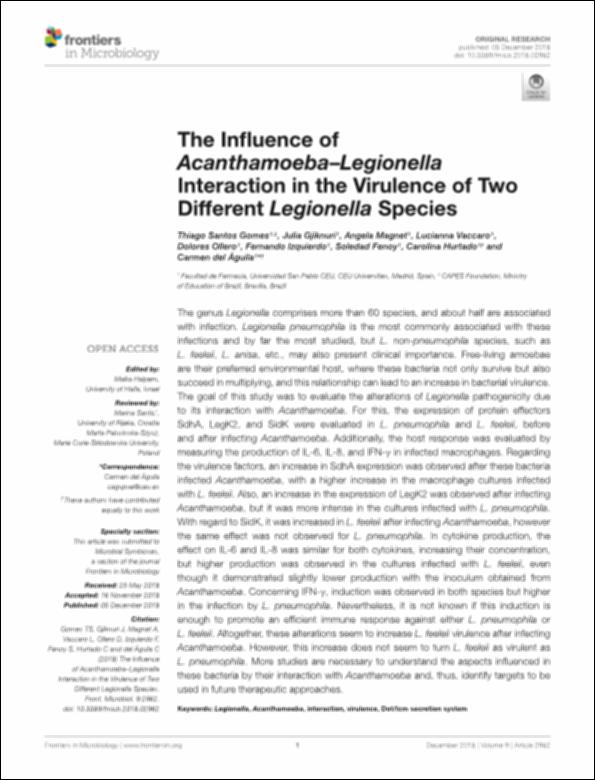Por favor, use este identificador para citar o enlazar este ítem:
http://hdl.handle.net/10637/15078The Influence of Acanthamoeba-Legionella Interaction in the Virulence of Two Different Legionella Species
| Título : | The Influence of Acanthamoeba-Legionella Interaction in the Virulence of Two Different Legionella Species |
| Autor : | Gomes, Thiago Santos Gjiknuri, Julia Magnet, Angela Vaccaro Muñoz, Lucianna Rosalía Ollero Baceiredo, Dolores Izquierdo Arias, Fernando Fenoy Rodríguez, Soledad Hurtado Marcos, Carolina Águila de la Puente, Carmen del |
| Materias: | Legionella; Acanthamoeba; Interaction; Virulence; Dot/Icm secretion system |
| Editorial : | Frontiers Media |
| Citación : | Gomes TS, Gjiknuri J, Magnet A, Vaccaro L, Ollero D, Izquierdo F, Fenoy S, Hurtado C, Del Águila C. The Influence of Acanthamoeba-Legionella Interaction in the Virulence of Two Different Legionella Species. Front Microbiol. 2018 Dec 5;9:2962. doi: 10.3389/fmicb.2018.02962. PMID: 30568639; PMCID: PMC6290054. |
| Resumen : | The genus Legionella comprises more than 60 species, and about half are associated with infection. Legionella pneumophila is the most commonly associated with these infections and by far the most studied, but L. non-pneumophila species, such as L. feeleii, L. anisa, etc., may also present clinical importance. Free-living amoebae are their preferred environmental host, where these bacteria not only survive but also succeed in multiplying, and this relationship can lead to an increase in bacterial virulence. The goal of this study was to evaluate the alterations of Legionella pathogenicity due to its interaction with Acanthamoeba. For this, the expression of protein effectors SdhA, LegK2, and SidK were evaluated in L. pneumophila and L. feeleii, before and after infecting Acanthamoeba. Additionally, the host response was evaluated by measuring the production of IL-6, IL-8, and IFN-g in infected macrophages. Regarding the virulence factors, an increase in SdhA expression was observed after these bacteria infected Acanthamoeba, with a higher increase in the macrophage cultures infected with L. feeleii. Also, an increase in the expression of LegK2 was observed after infecting Acanthamoeba, but it was more intense in the cultures infected with L. pneumophila. With regard to SidK, it was increased in L. feeleii after infecting Acanthamoeba, however the same effect was not observed for L. pneumophila. In cytokine production, the effect on IL-6 and IL-8 was similar for both cytokines, increasing their concentration, but higher production was observed in the cultures infected with L. feeleii, even though it demonstrated slightly lower production with the inoculum obtained from Acanthamoeba. Concerning IFN-g, induction was observed in both species but higher in the infection by L. pneumophila. Nevertheless, it is not known if this induction is enough to promote an efficient immune response against either L. pneumophila or L. feeleii. Altogether, these alterations seem to increase L. feeleii virulence after infecting Acanthamoeba. However, this increase does not seem to turn L. feeleii as virulent as L. pneumophila. More studies are necessary to understand the aspects influenced in these bacteria by their interaction with Acanthamoeba and, thus, identify targets to be used in future therapeutic approaches. |
| URI : | http://hdl.handle.net/10637/15078 |
| Derechos: | http://creativecommons.org/licenses/by-nc-nd/4.0/deed.es |
| ISSN : | 1664-302X |
| Fecha de publicación : | 5-dic-2018 |
| Centro : | Universidad San Pablo-CEU |
| Aparece en las colecciones: | Facultad de Farmacia |
Los ítems de DSpace están protegidos por copyright, con todos los derechos reservados, a menos que se indique lo contrario.


